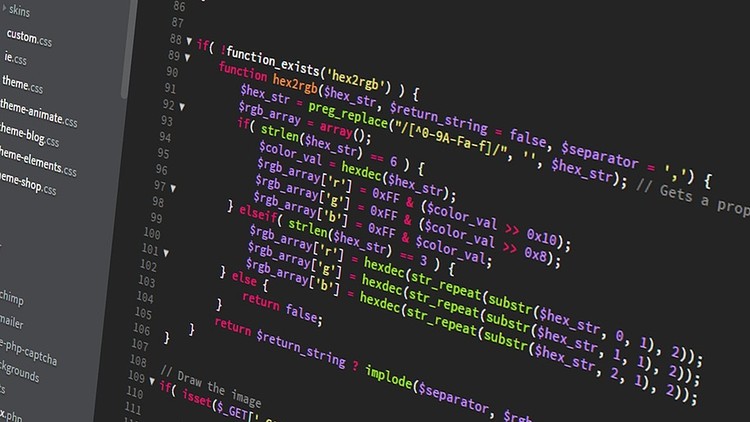Java Frameworks
Redprism came a long way intending to ‘Transform the Career and Lives’ of the individuals in the competitive world and up skilling their career, and creating a balance between the learning and implementing the real-time cases in education and achieve the dreams.

Java Frameworks
Introduction to Java Framework
Java frameworks are bodies of prewritten code used by developers to create apps using the Java programming language.
A Java framework is a type of framework specific to the Java programming language, used as a platform for developing software applications and Java programs.
A framework is a body of pre-written code that acts as a template or skeleton, which a developer can then use to create an application by filling in their own code as needed to get the app to work as they intend it to.
A framework is created to be used over and over so that developers can program their application without the manual overhead of creating every line of code from scratch.
Java frameworks may include predefined classes (categories of objects) and functions that can be used to process, input, and manage hardware devices, as well as interact with system software. This depends on the type of framework, the programmer’s skill level, what they’re trying to accomplish, and their own preferences.
Popular Java Frameworks
1. Spring
2. Hibernate
3. Struts
4. JSF
5. Vaadin
6. Google Web Toolkit
Advantages of Using Java Frameworks
1. Security
One of biggest advantages of using a framework is security. An extensive framework will generally have secure applications. If you are able to find a security hole or a vulnerability you can directly head towards the framework’s website. There the security issue can be fixed.
2. Support
Extensively used frameworks will have a large support group or large forums where one can have their issues resolved and questions answered. They also have documentation part where one can understand the framework.
3. Efficiency
A general task can take you hours or days to complete with many lines of code. With the use of Java frameworks, these can be done pretty easily with the help of pre-defined functionjs. The development becomes easier, quicker and effective.
4. Expense
Generally, the maintenance cost of the framework is very low. Also, most used structures are already present and help the developer to code faster. If the coding is done faster the expense will become lesser in every way whether it is time or effort.
Exclusive Key Factors at Redprism
Redprism is the best training institute to provide Java Framework training in Noida. We provide IT trainings on corporate standards that help students to be prepared for industries. REDPRISM offers best Java Framework training in Noida. Redprism is one of the best result oriented Java Framework Training Institute in Noida, offers best practically, experimental knowledge in Java Framework, training is conducted by 10+ years of experience in managing real-time projects. Redprism Noida is providing advanced level of Java Framework Training with live projects with 100% placement assistance with top industries. Here, at Redprism, laboratory are well-structured for Java Framework training in Noida where contenders learn the career oriented skills to uphold the career path. Our Java Framework training course has designed according to the latest technologies which are using in corporation at high level. REDPRISM structured Java Framework training content and syllabus in Noida according to student's requirement to be prepared for industries through which candidates can easily get placement in their dreamed companies and corporations.
Prime Features why to Join Red Prism?:-
· Industry Expert Trainers with 10-15 years of experience.
· Course content is designed by best Subject Matter Experts.
· Practical Assignments.
· Real Time Projects.
· Video recording of each and every session.
· Yours doubts are clarified by 24*7 assistance with our experts.
· We conduct regular Mock tests and certifications at the end of course.
· Certification Guidance.
· Recognized training complete certificate.
· 100% Placement Assistance.
· Less fees as compared to other institutes.
· Flexi payment options
· Scholarship Available
Course Content:-
v Hibernate Architecture
v Installation and Directory Structure
v Hibernate Data Types
v First Application using Hibernate
v Hibernate API
o Configuration
o SessionFactory
o Session
o Transaction
v Object Lifecycle in Hibernate
o Transient object
o Persistent object
o Detached object
v CRUD Operations using Session Methods
o Save, Persist, Save or update
o Update, Merge, Delete
o Load, Get
o Flush, Evict, Clear Etc.
o Versioning
v Primary Key Generators
o Assigned
o Increment
o Sequence
o Hilo
o Seqhilo
o Identity
o Foreign
o Native
o UUID
o Custom Generator
o Hibernate Query Language (HQL)
o Joins in Hibernate
o Batch processing and Native SQL
o Criteria API
o Criteria with Projections
v Inheritance Mapping
o Table per class
o Table Per Sub Class
o Table Per Concrete Class
v Component Mapping & Custom Mapping
v Collection Mapping
v Association Mapping
v Caching
v Connection Pool
o Default Connection Pool
o Server Supplied Pool
o Third Party Vendor Connection Pool
v Transaction and Concurrency
o Programmatic Transactions With JTA
o Optimistic Concurrency Control
o Pessimistic Concurrency Control
v Hibernate Pagination, Filter and Interceptor
v Connecting with Multiple Databases(Oracle, HypersonicSQL)
v Integrating Hibernate with Servlet
v Integrating Hibernate with Struts
v Working with Hibernate Annotations
v IDE-Eclipse, Netbeans
v Introduction to Spring Framework
v Introduction to Modules of Spring
v Spring Core Module
o Introduction to IOC
o Introduction to Spring Container
o Types of Dependency Injections
o Setter injection
o Constructor injection
o Resolving Constructor Injection Confusion
o Collection Dependency Injection
o Autowiring
o Dependency Checking
o Spring bean scopes
o Factory methods Configuration
o Bean Inheritance
o Bean Life Cycle
o Aware Interfaces
o Pre processor and Post Processors
o Working with properties files
o Multiple Configuration files
o Null string
o Method replacement
o Lookup method injection
o Spring expression language (spel)
o Annotation-based dependency injection
o Inner beans
o Alias Names
o Lazy Initialization
o Spring Boot Application Introduction
v Spring JDBC
o Drawbacks of plain JDBC
o Templates
o Jdbc Template
o Named Parameter Jdbc Template
o Simple Jdbc Template
o All the methods defined in Templates
o DAO Support classes
o Callback interfaces
o Driver manager Datasource
o Basic DataSource
o Examples of database access operations using spring jdbc
o Examples of accessing stored procedures using spring jdbc
o Rdbms Operation classes
Spring ORM
o Introduction to ORM
o Integrating with Hibernate
o Spring with hibernate without Hibernate Template
o Spring with hibernate with Hibernate Template
o Hiberante Template
o Hibernate DAO Support
o Callback interfaces
o Sping with JPA and other ORM integrations
v Spring AOP
o Introduction
o Need of AOP
o AOP Terminologies
o Types of Advices
o Types of Point cuts
o Programmatic based AOP
o Declarative Based AOP
o @AspectJ Style AOP support
v Spring Management
o Introduction to Transaction Management
o Declaring a Spring Transaction Manager
o Configuring isolation levels
o Configuring transaction propagation
o Transactions and integration testing
o Aop 2.0 Configuration driven Transaction Management
o AspectJ annotation based Transaction engagement
v Spring MVC
o Introduction To MVC
o Spring MVC Resources
o Spring MVC flow
o Dispatcher Servlet
o Controller Classes
o Hadler Mappings
o Validations
o View Resolvers
o Tiles in Spring MVC
o Message source
o MVC namespace (new in Spring 3.0)
o Spring Handler interceptors
o I18N
o PDF Views and Excel Views
o Spring MVC annotations
o Struts-Spring-Hibernate Integration
v Spring JEE
o Scheduling Based Applications with Spring
o Spring Webservices Integration
v Complexities involved in Spring framework
v Introduction to Spring Boot
v Spring Boot CLI
v Spring Boot Dependency Management
v Embedded server and its uses
v Spring Boot Annotations
v SpringBootApplication
v EnableAutoConfiguration
v SpringBootConfiguration
v Discussion on how automatic configuration works
v Spring MVC with Spring Boot
v Spring REST Service with Spring Boot
v Customizing Spring Boot application
v Environment based properties
v Spring Security with Spring Boot
v Customizing embedded server
v Using different embedded servers
v Spring Boot configuration properties
v Spring Boot logging
v Spring Boot Dev tools
v Spring Boot Actuator without security
v Spring Boot Actuator with security
v Hierarchical containers with Spring Boot
v Running Spring Boot application from command line
v Packaging Spring Boot application as a war file
v Running Spring Boot application in a non-embedded server
v Spring Boot database connectivity
v Introduction to Spring Data
v Repository and its hierarchies
v Spring Data derived queries
v Spring Data Pagination
v Spring Data Sorting
v Running a Spring boot application in Docker container
v Introduction
v The MVC Design Pattern
v System State and Business Logic
v JSP Pages and Presentation
v Components
v ActionServlet and Action Mapping
v Struts Control Flow
v Building Model Components
v Action Form Beans
v Forms and Form Bean Interactions
v Automatic Form Validation
v Building Controller Components
v The ActionServlet
v Action Form Classes & Action Classes
v The Action Mapping Implementation
v The Struts Configuration File
v Controller Configuration
v Module Configuration Files
v Add Struts Components To Your Application
v Logging in Struts Applications
v Introduction to JSF
v JSF Features
v JSF for Web Application
v JSF components
v JSF Tags, Life Cycle & Architecture
v JSF Renderers
v JSF HTML Tag Reference
v JSF Core Tag Reference
v JSF Facelet Tag Reference
v JSF Navigation, JSF with Ajax
v What Is an Enterprise Bean?
v What Is a Session Bean?
v What Is an Entity Bean?
v What Is a Message-Driven Bean?
v Client Access to Interfaces
v The Contents of an Enterprise Bean
v Naming Conventions for Enterprise Beans
v The Life Cycles of Enterprise Beans
Bean Managed Persistence
v Entity Bean Class
v Home Interface
v Remote Interface
v Mapping Table Relationships for BMP
v One-to-One Relationships
v One-to-Many Relationships
v Many-to-Many Relationships
v Primary Keys for BMP
Session Bean
v Session Bean Class
v Home Interface
v Remote Interface
v Helper Classes
v Creating the Application
v Stateless Session Bean
v Implementation Class
Container Managed Persistence
v Method Invocations
v Building and Running
v Creating the Database Tables
v Creating the Data Source
v Capturing the Table Schema
v Building the Enterprise Beans
v Primary Keys for CMP
v Finder and Selector Methods
Message Driven Bean
v The Application Client
v The Message-Driven Bean Class
v The onMessage Method
v The ejbCreate and EJB
v Remove Methods
v Advanced Enterprise Beans
v EJB: Query Language
Terminology
v Simplified Syntax
v Simple Finder Queries
v Navigate to Related Beans
v Other Conditional Expressions
v Select Queries
v BNF Symbols
v BNF Grammar of EJB QL
v FROM Clause
v Path Expressions
v WHERE Clause
v SELECT Clause
v ORDER BY Clause
v Overview
v What Is Messaging?
v When Can You Use the JMS API?
v Basic JMS API Concepts
v JMS API Architecture
v The JMS API Programming Model
v Administered Objects
v Connections
v Sessions
v Message Producers
v Message Consumers
v Writing Simple JMS Client Applications
v Junit framework
v What is Junit
v About @Before, @After, @Test
v How to write test cases
v Various types of assertions
v How to assert exceptions
v Benefits of Logging framework over Console O/P
v Available logging frameworks
v Log4j Vs Slf4j
v Levels of logging
v Manage Logger configuration through log4j.XML / logback.xml






